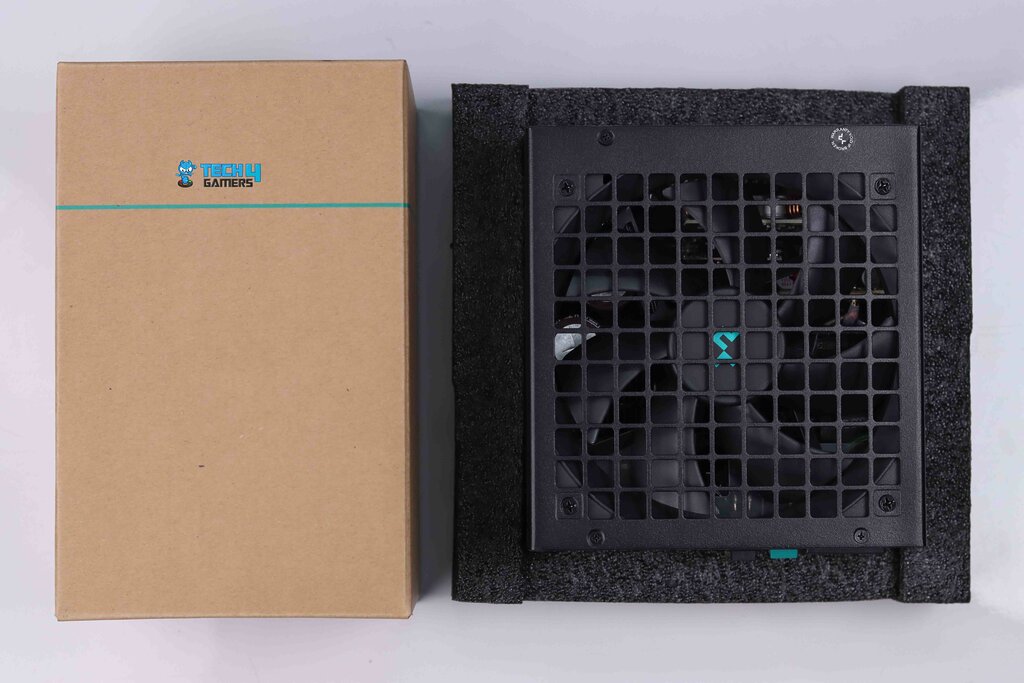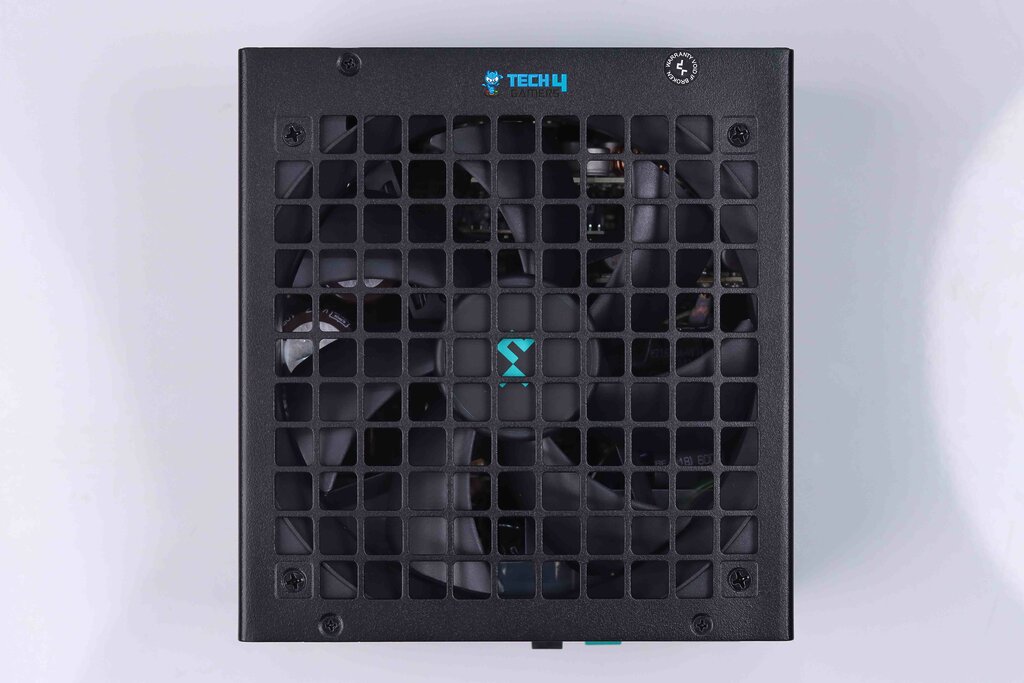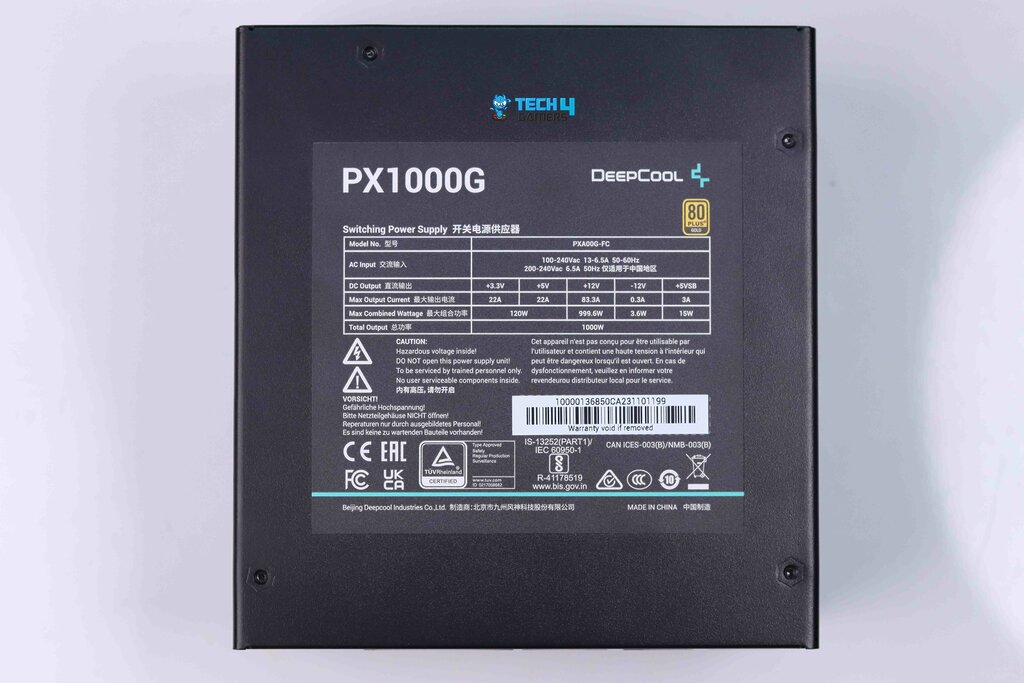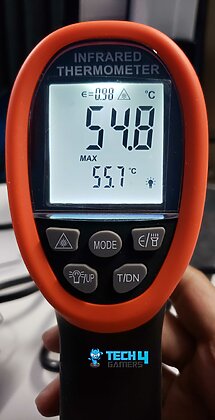More Than Just Power!
Review Summary
DeepCool has opted for one of the best and currently the most adapted ATX3.0 platform from CWT, which performed exceptionally well in all the major tests we performed. PX1000G’s Hybrid Fan mode gives this PSU an upper edge over other brands for its silent fan operation during light workloads.
Hours Tested: 17
Overall
-
Value - 9.8/10
9.8/10
-
Build Quality - 9/10
9/10
-
Performance - 9.5/10
9.5/10
-
Future-Proofing - 9/10
9/10
Pros
- Hybrid Fan mode allows completely silent operation in light loads
- Less expensive than its Platinum counterpart but still has identical performance
- 10 Years of warranty
Cons
- None
Three versions are available in the PX series from DeepCool’s latest release: an 850W, a 1000W, and a 1200W ATX 3.0 PSU. All of these units are available in two colors: black and white. For this review, I will be testing the DeepCool PX1000G. I have also tested the PX1000P; make sure to check it out.
The capacity to provide three times the entire GPU power and twice the whole system power in only 0.1 milliseconds means that power spikes will never be a problem. For current and future generations of PCs, the PX1000G’s dedicated 12VHPWR, two EPS, and three PCI-e connectors provide reliable power. For optimal performance under normal load conditions, this product has been Cybenetics Platinum and 80 Plus Gold certified.
The use of complete Japanese 105C capacitors ensures solid and dependable power. Using the dual main capacitor design, the PX1000G can maintain a hold-up time of at least 16ms even while operating under full load. For particularly power-demand GPUs, the PX-G can provide up to 600W thanks to its included PCI-e Gen 5.0 12VHPWR connection. Lastly, for your peace of mind, DeepCool provides a 10-year guarantee for this power supply. So, let’s find out if it is worth investing in the new PX series.
Key Takeaways
- The DeepCool PX1000G has impressive performance, reliability, and user-centric features. Engineered to meet the demands of modern gaming and computing systems, this PSU adheres to the latest ATX 3.0 standard, ensuring compatibility with current PC builds.
- What I liked about the DeepCool PX1000G is its excellent performance across various tests, including voltage regulation, efficiency, and temperature performance.
- What I did not like about the DeepCool PX1000G is that it may not be suitable for high-end gaming PCs requiring higher power capacities, such as 1200W or 1600W units.
- The DeepCool PX1000G is a perfect fit for gamers who demand reliable and stable power delivery for high-performance gaming rigs and will appreciate the PX1000G’s robust features and performance.
- Why you can trust Tech4Gamers: Our reviews are based on dedicated hands-on testing by our team of experienced hardware experts. Find out more about how we test.
Here are the specifications:
| Type | ATX12V V3.0 |
| Product Dimensions | 150×160×86mm (W x L x H) |
| Efficiency certification | 80 Plus Gold/Cybenetics Platinum |
| Fan Size | 135mm |
| Fan Bearing | FDB (Fluid Dynamic Bearing) |
| Topology | Active PFC + Half Bridge LLC + Synchronous Rectification for 12V & DC to DC for 5V & 3.3V |
| Capacitors | Full Japanese 105C rated Electrolytic & Polymer Capacitors |
| Power Good Signal | 100-150ms |
| Hold Up Time | ≥16ms |
| Efficiency | ≥90% Under Typical Load (50% Loading) |
| Protection | OPP/OVP/SCP/OTP/OCP/UVP |
| Operation Temperature | 0 – 40℃ |
| Regulatory | CE/FCC/CCC/TUV-RH/RCM/EAC/CAN ICES-003(B)/NMB-003(B)/UKCA/BIS/KC; |
| Erp Regulation | Erp 2014 |
| Environment Protection | WEEE/RoHS/Triman |
| MTBF | 100,000 Hours |
Packaging & Unboxing
There are two sections to the PX1000G’s packaging: a white sleeve that displays an 80 Plus Gold rating and a full-color picture of the supply and a plain brown box that pulls out to reveal the box contents. The graphs on the back of the box showcase various key elements, such as the efficiency curve, the fan speed characteristics, and the usual information seen on PSUs.
Upon lifting the top flap of the brown cardboard box, we are greeted with the PSU, which is encased between two thick black foam slabs and a smaller box housing the necessary cables and accessories. The smaller container housing the cables and extras has a subtle design with only one blue-green line. Lastly, a brown-sleeved package contains a small user handbook manual and information about support.
Box Content & Cables
The number of cables provided by DeepCool is similar to that of 1000W and 1200W units, with a 150 mm gap between each connection on SATA cables, which is perfectly sufficient. I can see a plethora of cables to accommodate any and all build options. As I previously mentioned, the PX1000G’s bundled accessories can be found in the smaller package.
Included in the package are the typical components for a PSU that includes a standard power cord, four screws, velcro cable ties with the DeepCool logo, and, most surprisingly, a knockoff PSU tester. Finally, the PX1000G came with all the necessary cables. Without sleeving, each wire is a flat black ribbon style. A Main Power 24-pin cable, two EPS CPU cables with two 4+4 pins, two SATAx4 cables, three 6+2-pin PCIe cables, one 600w 12VHPWR cable, and a four-plug MOLEX cable are all part of the package.
Design
When you take the PX1000G out of its box, the square ventilation pattern of the fan grille becomes most noticeable. The power supply’s top cover conceals a large 135 mm fan. After we open the unit, we’ll take a closer look at this. On the fan hub, you can see the DeepCool logo displayed in the middle. Notably, the product is well-made and has a subtle design.
Various case designs can easily fit its fairly small dimensions of 150x160x86mm (WxLxH). The side panels’ little engraved “DC” logo is a nice touch. It’s subtle yet impactful. On the PX1000G’s back, you’ll find the power input, a power rocker switch in teal green, and a button for Hybrid Mode.
In hybrid mode, the PX1000G’s inbuilt 135mm fan can be set to wait to operate until the temperature reaches a certain threshold. While the PX1000G’s fan grille features a square ventilation design, the one on the back is much smaller. A label displaying the power distribution across the rails is located on top of the power supply. On the +3.3V and +5V rails, the supply can deliver 22A, and on the +12V rail, 83.3A.
Cable Connections
On the other side, you’ll find the modular bay, which consists of two rows of connections with labels that simplify the building process. The PX1000G displays all of the connectors on the cable input side. There is an 18+10 pin arrangement for the 24-pin cable input on the motherboard. After that, the lower inputs can be either PCIe or CPU cables, and the same is true for the lower inputs.
The 12VHPWR Connector is aesthetically pleasing as it has a different color connector, making it easy to identify whether the user was successful in plugging the cable in and lowering the likelihood of problems caused by human error.
Fan

A Fluid Dynamic bearing fan from Hong Hua, the HA13525H12SF-Z, has been chosen by DeepCool, which is an industry standard at this point in almost all the good quality high-end PSUs. This one has a diameter of 135 mm and has a rating of 12V, 0.5A, which is capable of running at speeds of up to 2300 RPM.
Unlike other PSUs that use the same platform from CWT, DeepCool has requested a slight design change in order to add Hybrid Fan mode in PX1000G. DeepCool really wanted their customers to not get even slightly annoyed by the fan noise. You can switch on semi-fanless operation with the PX1000G.
Once the load on the system reaches a certain point, the 135mm FDB fan is going to shift from its zero RPM condition to hybrid mode. The automatic start-stop fan kicks in when the PSU reaches a certain temperature and turns off when the PSU drops below that temperature. Once the PSU is operating, the fan speed will likewise be dependent upon its temperature.
Teardown & Component Analysis

CWT has been the preferred OEM for almost all DeepCool PSUs. Intel’s recent ATX3.0 specifications made it slightly difficult for OEMs to adapt quickly to the latest ATX specs with not much time in hand. CWT has done quite an amazing job in improving their already existing platforms and making them ATX3.0 compatible with slight design changes.
PX1000G uses a similar improved platform from CWT, which is ATX3.0 compatible and comes equipped with a 12VHPWR connector for Nvidia’s latest GPUs. The primary side uses Active PFC, Half Bridge & LLC topology & on the secondary we see Synchronous Rectification for 12V & DC-DC converters for minor 5V & 3.3V rails, which you would expect from any Gold-rated PSU these days. But the components selection is pretty good.
DeepCool has opted for top-of-the-line Japanese capacitors from Nippon Chemicon for both primary bulk capacitors and secondary ones, along with the rest of the Polymer capacitors. DC-DC converter for minor 5V & 3.3V rails.

The main transformer that converts high voltage coming from the Primary side to 12V on the secondary side utilizes a direct connection to the vertical PCB where 12V rail MOSFETs are soldered. This vertical PCB approach maximizes efficiency and gives adequate room for the MOSFETs to remain cool during operation.
PSU Load Testing
12V & Minor Voltage Rails Regulation

| Load in % | 12V | 5V | 3.3V |
| 20% | 12.15V | 5.06V | 3.30V |
| 50% | 12.05V | 5.05V | 3.30V |
| 70% | 12.02V | 5.04V | 3.29V |
| 90% | 11.98V | 5.04V | 3.29V |
| 100% | 11.99V | 5.04V | 3.29V |
The 12V regulation is maintained tightly. Although the ATX3.0 specifications now allow 12V rails to go even lower (down to 11.2V, compared to the previous limit of 11.4V), there have been no instances of modern platforms going that low on their 12V rail. The same applies to PX1000G, which has an excellent voltage tolerance for the most important 12V rail.
PSU Efficiency

| Load in % | Power Factor | Efficiency |
| 20% | 0.949 | 91.10% |
| 50% | 0.977 | 92.90% |
| 70% | 0.981 | 92.20% |
| 90% | 0.983 | 91.40% |
| 100% | 0.984 | 91.70% |
The efficiency of this PSU is exceptional even when compared to gold standard units, which makes this platform highly efficient. CWT has dedicated a considerable effort towards ensuring that their ATX 3.0 compliant PSUs are designed to enhance their platform’s efficiency. As a result, many manufacturers are now opting to adopt their platforms. Notably, this platform is exceptionally efficient, even by gold standards.
Voltage Ripple Performance
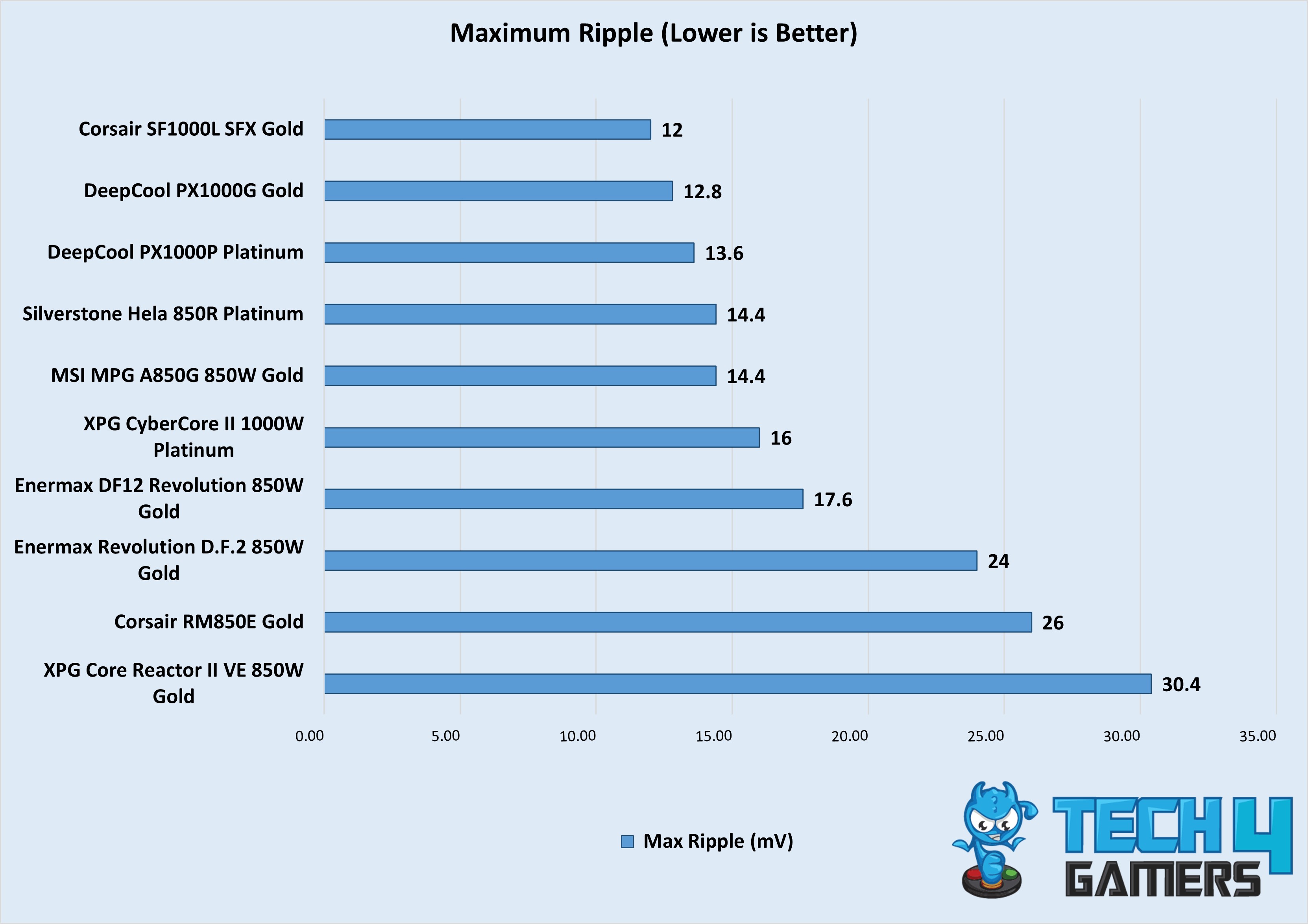
| Load in % | Voltage Ripple |
| 20% | 3.2mV |
| 50% | 9.6mV |
| 70% | 10.4mV |
| 90% | 11.2mV |
| 100% | 12.8mV |
The voltage ripple performance of PX1000G is highly impressive. CWT’s latest platform seems almost ripple-free, even under maximum load. This low ripple performance can be useful during power excursions, such as power spikes that can now go as high as 200% for 0.1ms. If you are into extreme overclocking, this product will suit your needs.
Beacon Of Reliability And Performance
Temperatures
Thanks to the efficient platform, the PSU’s temperatures were well within the specified limits during the testing phase, and there was no cause for concern. Throughout the testing, the PSU’s operations remained impressively cool, which is a testament to the quality of the design and construction.
In short, the PSU performed admirably, and there were no issues whatsoever with its temperature or performance. The maximum temperature on the back was found to be 40.1C and 54.8C on the exhaust. While the maximum hottest temperature on the connector’s side was 42C.
12VHPWR Cable Performance On Max Load
12VHPWR cable sustained the load of 600W without breaking a sweat at the voltage level of 11.89V.
Should You Buy It?
After testing the DeepCool PX1000G, the final question is, should you buy it?
But It If
✅You’re searching for a well-balanced PSU: The DeepCool PX1000G allows you to extract maximum performance from your system through overclocking, whether it’s your processor or GPU. It caters to your needs without breaking the bank, making it a great option for those who don’t require extreme overclocking, which usually necessitates high-end PSUs.
✅You’re interested in having a silent fan operation. The DeepCool PX1000G offers silent fan operation, even though I advise against running your PSU on silent mode constantly. This is because it can reduce the lifespan of your components. Cooler temperatures can increase the life expectancy of your components.
Don’t Buy It If
❌You are a high-end build user: Mainstream PSUs have capacities of 1200W and 1600W, which are more suitable for high-end gaming PCs. You might want to consider other options in the PXs series, such as the 1200W variant, which would easily run the RTX 4090.
❌You are an efficiency aficionado: The DeepCool PX1000P would be a better option than the DeepCool PX1000G. This is because it has a Platinum standard, even though there is only a negligible 2-3% difference in performance between the two. If we calculate the real values, it would only come down to a few points. Since you already have a more efficient option from the same manufacturer, it would be wise to opt for that one.
Final Verdict
This state-of-the-art CWT platform has undeniably shown how valuable it is, and the DeepCool PX1000G provides excellent performance across the board. The price is reasonable considering the high power output levels, and the build quality is excellent. This power supply is likely to fit into a wide variety of chassis thanks to its small footprint. As far as it goes, the PSU is working fine technically, and testing revealed no worrisome concerns.
It performed well in a variety of tests and had excellent, if not outstanding, performance. All rails fall well within the industry-rated benchmark, making ripple suppression a particularly strong aspect of the supply. All things considered, buyers can rest easy knowing that this PSU has a completely modular design, has highly efficient components, comes with a 10-year warranty, and uses Japanese main-stage capacitors rated at 105C.
More DeepCool Products We’ve Tested:
- DeepCool LS720 White
- DeepCool AK620 Digital
- DeepCool LT520
- DeepCool Assassin IV
- DeepCool LT720 White
Thank you! Please share your positive feedback. 🔋
How could we improve this post? Please Help us. 😔
[Hardware Reviewer]
After many years of exploiting various pieces of hardware, Abdul Hannan now serves as an editor at Tech4Gamers. He’s been in the PC hardware reviewing industry for almost a decade, and his staff of passionate geeks and reviewers is second to none.
Abdul Hannan is constantly seeking new methods, you will always see him running into New Computer Courses to improve the performance of his computer components since he is an ardent overclocker. He is well-known for providing the most extensive and unbiased analysis of the newest and greatest hardware for PC gaming, including everything from GPUs to PSUs.


 Threads
Threads

